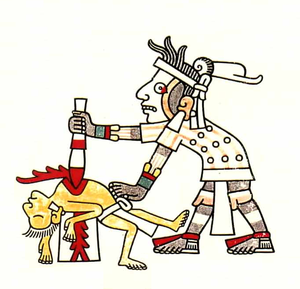Topic 1.4 State Building in the Americas
The period 1200 to 1450 saw impressive continuities in terms of culture and state-building in the Americas. Societies in Mesoamerican and the Andes region forged large complex civilizations. The most successful to arise during this period were the Mayan, the Aztecs, and the Incas. These civilizations, as with their counterparts on the other side of the world, were made possible by massive agricultural
surpluses that supported hierarchical and complex societies. In Mesoamerica, the most important crop was maize. In the Andes it was potatoes. All three had to develop highly sophisticated irrigation and agricultural techniques to farm the harsh forests, lowlands, and mountains of their terrain. So critical was the need to manage water in these civilizations that one prominent historian has labeled them "hydraulic" civilizations. [1] They did all this without the benefit of wheeled vehicles, metal tools, or large pack animals. Notwithstanding these limitations, each developed complex hierarchical societies, advanced knowledge of astronomy and calendars, and formulated religious ideologies of military conquest.
- The Mayan
- Borrowing heavily from their parent civilization, the Olmecs, the Mayans reached their first peak of civilization between 250 to 900 C.E., then again between 1200 and 1450 C.E. One of the most impressive aspects about their ascendancy is how they overcame "extraordinary ecological challenges to create a very sophisticated and productive agriculture that was the key to their development." [2] They learned to trap rich river silt with terraces to replenish the fertility of the thin, poorly drained topsoil of southern Mexico. [3] The increased agriculture allowed the Mayan civilization to greatly expand, driving them to find increasingly creative means of collecting and storing water during the dry seasons and as insurance against unpredictable summer rains. [4] Politically, the Mayan were not a centralized empire, but rather were organized into over fifty small city-kingdoms often competing against each other. As in ancient Greece, cities sometimes formed opposing military alliances which shifted and reformed as circumstances changed. Tikal, the most powerful of these city-kingdoms, lasted eight centuries. About fifty years before the Spanish showed up in the Americas, the Mayan civilization fell apart, probably due to civil wars between the city-states.
- The Aztecs
- After the demise of the Toltec empire around 1200 C.E., an ethnic group called the Mexica migrated southeast and eventually settled on an island in the marshy areas of Lake Texcoco. There they built the settlement that would later become the great Aztec capital Tenochtitlan (the Mexica people came to be called Aztecs, a reference to the home of their ancestors.) By raking the muck of the lake into small islands above the surface of the water (called chinampas), they were able to produce abundant agriculture to support a thriving civilization. By the early 1400s the Mexica had defeated their neighbors and demanded tribute from them. Thus was born the Aztec empire. At times, the empire was actually a triple alliance of three major cities who combined to project their rule over most of Mesoamerica, about 12 million people. [5] The Aztec Empire was a loose collection of conquered areas from which the core at Tenochtitlan collected heavy tribute. Every year Aztec rulers demanded massive amounts of clothing, jewelry, food, animals, and other materials from locations across their vast domain. Throughout the empire there was a significant market for craft goods and most all cities and villages had thriving markets. The expansion of the empire was motivated in part by its religious belief. The Aztec believed that their gods were engaged in an ongoing struggle against the stars. The keep the fight going, and keep the sun moving across the sky, the gods needed human blood that was provided by an elaborate ritual of mass human sacrifice.
- The Inca
In the 14th and 15th centuries, the Incas built the most centralized empire in the Americas during this time. Building on the base of the Chavin and Moche civilizations, they spread their civilization along the 2500 mile spine of the Andes Mountains on the western side of South America. Extensive terracing allowed them to practice agriculture in these high altitude and mountainous regions where they grew potatoes, maize, beans and peppers. There was a small merchant class, but trade was controlled by the government. Unlike the diverse societies of the Mayan and Aztec civilizations, the Incas practiced cultural imperialism, forcing their language and religion on conquered people. The Incas centralized their rule through a complex bureaucracy and an extensive network of roads and bridges. [6] Their ruler (originally called the "Inca") was believed to be a god. A large professional army was supported by peasants who owed compulsory labor to the state.
- ↑ The scholar was Karl Wittfogel, cited in The History of Latin America: Collision of Cultures, (2007), Marshall C. Eakin, pp. 31-32.
- ↑ The History of Latin America: Collision of Cultures, (2007), Marshall C. Eakin, pp. 31-32.
- ↑ Traditions and Encounters, 5th ed., (2007), Jerry Bentley, p. 111.
- ↑ Panorama: A World History, (2015), Ross E. Dunn and Laura J Mitchell, p. 230.
- ↑ Traditions and Encounters, 5th ed., Bentley, p. 418.
- ↑ The History of Latin America: Collision of Cultures, (2007), Marshall C. Eakin, p. 37.


